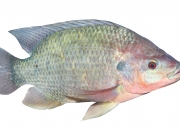By Thomas D. Kocher
Department of Zoology & Program in Genetics
University of New Hampshire
Basic tilapia genetics
We are at an early stage in the genetic domestication of tilapia. During the approximately 40 year history of intensive culture, the genetic resources of tilapia have been poorly managed. The genetic problems now manifesting themselves are of several kinds. First is the loss of pure species through mismanagement of interspecific hybridization (McAndrew 1993), a technique which has been used to produce all-male fry which have a higher growth rate in production systems (Hickling 1960; Hulata et al.1983). One popular commercial strain is thought to contain genes from as many as four species (McAndrew et al. 1988). A second problem is high levels of inbreeding depression. Primary collections of wild broodstock frequently consisted of a small number of individuals. These were serially distributed, so that genetic problems have been passed from country to country, and farm to farm. Eknath et al. (1993) compared four strains farmed in the Philippines with four strains newly isolated from wild populations in Africa. The best performing strains were those most recently isolated from nature, consistent with the idea that domesticated strains suffer from inbreeding depression (Tave and Smitherman 1980; Hulata et al. 1986; Teichert-Coddington and Smitherman 1988). A survey of 18 microsatellite DNA markers in several commercial strains found some strains with heterozygosities less than 10% of that found in wild strains (Kocher et al., unpubl.). In addition to inbreeding, it is likely that negative selection for growth rate has occurred during the propagation of many stocks. Finally, there is evidence for contamination of genetically improved strains by introgression from feral species (Macaranas et al. 1986).
In recent years attention has focused on a single species, O. niloticus, and research has begun to overcome some of the main problems associated with farming this species (Pullin and Capili 1988; Tave 1988). Large scale genetic improvement programs have been established for O. niloticus in Asia (Eknath et al. 1993) and genetic methodologies to control sex have now resulted in the reliable production of all-male fry to help overcome the problems associated with excessive fry production in on-growing ponds (Mair et al. 1995). Future research will aim to improve the performance and expand the environmental tolerance of this species into areas of lower temperatures and higher salinities. These developments will require a greater use of genetic markers for the management of broodstock, identification of loci controlling quantitative traits (QTLs) and the development of superior strains through marker-assisted selection. Development of tilapia breeds is at a point where tremendous gains could be made with a relatively small technical input.
Tilapia genome project
To support genetic improvement of tilapia, an international effort has begun to compile a map of the O. niloticus genome (Kocher, 1997). Until recently, only a few genes had been mapped in tilapia. Hussain et al. (1994) used meiotic gynogens (diploid progeny produced by suppression of the 2nd meiotic division) to map gene-centromere distances for six allozyme loci and two color loci. The karyotypes of the various tilapia species are highly similar, consisting of 22 pairs with no morphologically distinct sex chromosomes. In fact only two pairs are recognizable, the remaining 20 being similar in size and acrocentric morphology (Majumdar and McAndrew, 1986). At the molecular level, the genome size of several species has been measured at around 1pg (1,000Mb), about one-third the size of many mammalian genomes.
Recent work has focused on mapping DNA polymorphisms, including microsatellites (e.g. Lee and Kocher, 1996) and anonymous fragment length polymorphisms (AFLPs; Vos et al. 1996). These markers are highly polymorphic, and easily scored from small tissue biopsies (e.g. fin clips). We have recently completed a first genetic linkage map for a tilapia (Oreochromis niloticus) (Kocher et al., 1997). The segregation of 62 microsatellite and 112 AFLP polymorphisms was studied in 41 haploid embryos derived from a single female. We have identified linkages among 162 (93.1%) of these markers in a map which spans approximately 700 centimorgans. We anticipate that the final length of the genetic map for this species will be just over 1000 cM.
This linkage map is complete enough to begin mapping genes responsible for production traits. For example, if we wanted to combine genes from two strains to produce a superior line, we might hybridize the strains and use the DNA markers to track the segregation of chromosomal segments in the F2 progeny. Desirable genes could be tracked and selected using linked DNA markers from the map.
Transgenic tilapia
Another approach to genetic improvement is the insertion of new genes or gene constructs into the genome (transgenics). Many of the technical hurdles in the production of transgenic animals have been surmounted, and the introduction and expression of foreign genes is becoming routine. At least two groups have produced introduced additional copies of the growth hormone gene into tilapia and found an enhanced growth response (Martinez et al. 1996; Rahman et al. 1997). It is not yet clear whether these insertions are stable over many generations, or what additional effects they may have on the physiology of the animal. To be useful, these constructs will have to be carefully maintained in a selective breeding program. Application of this technology to other
production characteristics awaits the identification of genes responsible for these traits.
Acknowledgments
Research on the tilapia genome has been funded by the USDA NRICGP (#94-37205-1033).
References
Eknath, A.E., M.M Tayamen, M.S. Palada-de Vera, J.C. Danting, and R.A. Reyes, 1993. Genetic improvement of farmed tilapias: the growth performance of eight strains of Oreochromis niloticus tested in different farm environments. Aquaculture 111: 171-188.
Hickling, C.F. 1960. The Malacca Tilapia hybrids. J. Genetics 57:1-10.
Hulata, G., G. Wohlfarth and S. Rothbard. 1983. Progeny-testing selection of tilapia broodstocks producing all-male hybrid progenies--preliminary results. Aquaculture 33:263-268.
Hussain, M.G., B.J. McAndrew, D.J. Penman and P. Sodsuk., 1994. Estimating gene-centromere recombination frequencies in gynogenetic diploids of Oreochromis niloticus L., using allozymes, skin colour and a putative sex-determination locus (SDL-2). pp. 502-509 in A.R. Beaumont (ed). Genetics and Evolution of Aquatic Organisms. Chapman and Hall.
Kocher, T.D. 1997. Tilapia Status Report. Proceedings of the Aquaculture Species Genome Mapping Workshop, May 18-19, Dartmouth, Massachusetts.
Kocher, T.D., W.-J. Lee, H. Sobolewska, D. Penman and B. McAndrew 1997. A genetic linkage map of a tilapia (Oreochromis niloticus). Submitted.
Lee, W.-J., and Kocher, T. D. 1996. Microsatellite DNA markers for
genetic mapping in the tilapia, Oreochromis niloticus, J. Fish Biology 49:169-171.
Macaranas, J. M., N. Taniguchi, M. J. R. Pante, J. B. Capili and R. S. V. Pullin, 1986 Electrophoretic evidence for extensive hybrid gene introgression into commercial Oreochromis niloticus (L.) stocks in the Philippines. Aquaculture and Fisheries Management 17: 249-258.
Majumdar, K.C. and B.J. McAndrew. 1986. Relative DNA content of somatic nuclei and chromosomal studies in three genera, Tilapia, Sarotherodon, and Oreochromis of the tribe Tilapiini (Pisces, Cichlidae). Genetica 68:175-188.
Martinez, R., M.P. Estrada, J. Berlanga, E. Guillen, O. Hernandez, 1996. Growth enhancement in transgenic tilapia by ecotopic expression of tilapia growth hormone. Mol. Mar. Biol. and Biotech.5:62-70.
McAndrew, B. J. 1993. Sex Control in Tilapiines. pp. 87-98 in Recent Advances in Aquaculture IV , edited by R.J. Roberts and J. Muir. Blackwell Scientific Publishing.
McAndrew,B.J., F.R. Roubal, R.J. Roberts, A.M. Bullock and I.M. McEwen. 1988. The genetics and histology of red, blond and associated colour variants in Oreochromis niloticus. Genetica 76:127-137.
Pullin, R.S.V. and Capili, J.B. 1988. Genetic improvement of tilapias: problems and prospects, pp. 259-265 in The Second International Symposium on Tilapia in Aquaculture; edited by R.S.V. Pullin, T. Bhukaswan, K. Tanguthai, and J.L. Maclean. ICLARM Conference Proceedings 15, Manila.
Rahman, M.A., A. Smith, R. Mak, H. Ayad and N. Maclean. 1997. Expression of an exogenous piscine growth hormone gene results in enhanced growth in transgenic tilapia (Oreochromis niloticus). Sixth International Symposium on Genetics in Aquaculture, Stirling, U.K.
Tave, D., 1988 Genetics and breeding of tilapia; A review, pp. 285-293. In: The Second International Symposium on Tilapia in Aquaculture; edited by R.S.V. Pullin, T. Bhukaswan, K. Tanguthai, and J.L. Maclean. ICLARM Conference Proceedings 15, Manila.
Tave, D. and R.O. Smitherman, 1980 Predicted response to selection for early growth in Tilapia nilotica. Trans. Amer. Fish. Soc. 109: 439-445.
Teichert-Coddington, D.R. and R.O. Smitherman, 1988 Lack of response by Tilapia nilotica to mass selection for rapid early growth. Trans. Amer. Fish. Soc. 117: 297-300.
Vos, P., Hogers, R., Bleeker, M., Reijans, M., van de Lee, T., Hornes, M., Frijters, A., Pot, J., Peleman, J., Kuiper, M., and Zabeau, M., 1995. AFLP: a new technique for DNA fingerprinting, Nucleic Acids Res, 23, 4407-4414.





